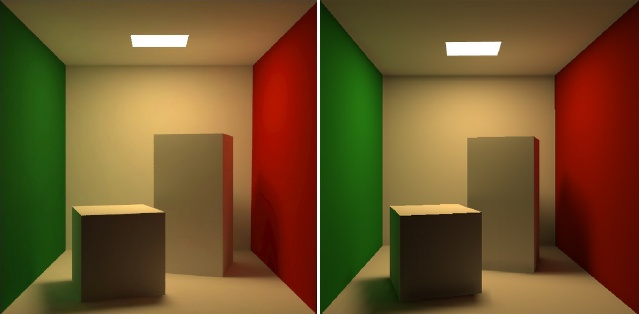 |

Submitted by , posted on 19 October 2001
|
 |

Image Description, by

I guess this is just as much a public announcement as it is an IOTD. So if
you're not interested in any announcments I might be inclined to make,
then feel free to ignore the text and enjoy the pic.
I've been working on some radiosity code lately. I've paid a lot of
attention to accuracy and correctness. In the process, I found myself
comparing my results to the original cornell box results.
On the left, you'll see the original cornell box image (as generated at
Cornell University) and on the right, you'll see the one generated by the
new radiosity processor I've been working on.
If you look closely, you'll see that the images are not exact. This is for
a few reasons. First, the original cornell box was not processed with RGB
light, but rather using a series of measured wavelenghts. So I guessed at
the RGB values and surface reflectivities when I generated my image. I
also didn't bother matching their camera position and FOV -- I just
"moused" it. :) The image on the right was post-processed with a gamma
value of 2.2 -- no other post-processing was used. Finally, the image on
the right is rendered using lightmaps.
I don't know how long it takes to generate the original cornell box, but
it takes me about 12 seconds on my 1Ghz P3. It required over 1200
iterations to reach a convergence of 99.999% (theoretically, you'd need to
run an infinite number of iterations to reach a full 100% convergence.)
If you're impatient, a very reasonable result (negligible difference to
the one above) can be had in just a couple seconds.
About the tool:
It's also a lightmap generator/packer; it will generate tightly packed
lightmaps for an entire dataset and generate proper UV values for the
lightmaps. In other words, you want lighting for your game, you just hand
your geometry to this tool, and it spits out your lightmaps and UV values.
A lot of new concepts went into the development of this tool:
No use of hemicubes or hemispheres; uses a completely analytical
solution with a perfect visibility database generated by a fairly
well optimized beam tree. There isn't a single ray traced in the
generation of the image above.
Geometry is stored in a clipping octree, and at each octree node, a
clipping BSP tree is built. The BSP uses the a new generation technique
that has proven to vastly improve the speed of building the BSP as well
as great reduction in tree depth and splits. From this, we perform
the radiosity process on the precise visible fragments of polygons.
New adaptive patch technique which is anchored to the speed of the
processing itself. As with all progressive refinement radiosity
processors, the further along you get, the slower it gets. This
adaptive patch system is keyed to the progress, and almost keeps the
progress running at a linear speed. This trades accuracy for speed,
but only when the amount of energy being reflected is negligible.
This is also completely configurable.
Other accuracy options, including using the actual Nusselt Analogy
for form factor calculation (about 5% slower, much more accurate.)
Also, for accuracy, every single light map texel is an element, and
it gets this almost for free. :)
I'm considering doing a 12-week course at GameInstitute.com on radiosity
somtime in the future (if they'll have me :). The course will most likely
include this technique as well as other common techniques. It will
probably also cover lightmap generation as well as the other techniques
(new and old) employed in this tool.
At some point, I also hope to release full source to this tool to the
public.
|
|

